Phison PS5008-E8 NVMe SSD Technical Preview With Performance Analysis
512GB Class Performance Testing
Comparison Products
We stuffed our 512GB-class NVMe charts with products, but Phison is targeting two of them specifically. The entry-level Intel 600p will be the biggest competitor, but the Western Digital Black PCIe is also a contender.
Our PS5008-E8 sample is an early reference design that has not been fully optimized. For example, our sample doesn't have every power state programmed into the firmware, so our notebook battery life results will be far lower than the retail products coming in October. Our sample also hasn't been updated with the latest garbage collection code, which will hurt performance in our steady-state tests.
Sequential Read Performance
To read about our storage tests in-depth, please check out How We Test HDDs And SSDs. We cover four-corner testing on page six of our How We Test guide.


The PS5008-E8 reached the claimed 1,600 MB/s sequential read performance without using test methods designed to take advantage of the NVMe protocol. That usually consists of testing with multiple workers and unrealistic queue depths. This strong performance under normal conditions is important because applications have not caught up to NVMe's capabilities.
Phison achieved its goal of outperforming the 600p and Black PCIe. The E8 reference design also outperformed the Adata SX8000. The SX8000 uses the same controller as the 600p but pairs it with IMFT MLC flash.
Sequential Write Performance


We didn't expect our early-production E8 to outperform the Adata SX8000 512GB with 3D MLC flash. The two drives were very close in our sequential write test. We see a larger delta between the E8 and its two primary competitors. The drive nearly doubles the 600p's sequential write performance and doubles the Black's performance.
Sequential Write Performance Cache
If you recall, the Toshiba XG5 high-performance NVMe SSD with the same BiCS TLC didn't suffer a significant performance loss after we saturated the SLC buffer. Our E8 reference design shows a large drop-off, but this may change when the firmware is final and products come to market.
Get Tom's Hardware's best news and in-depth reviews, straight to your inbox.
Random Read Performance
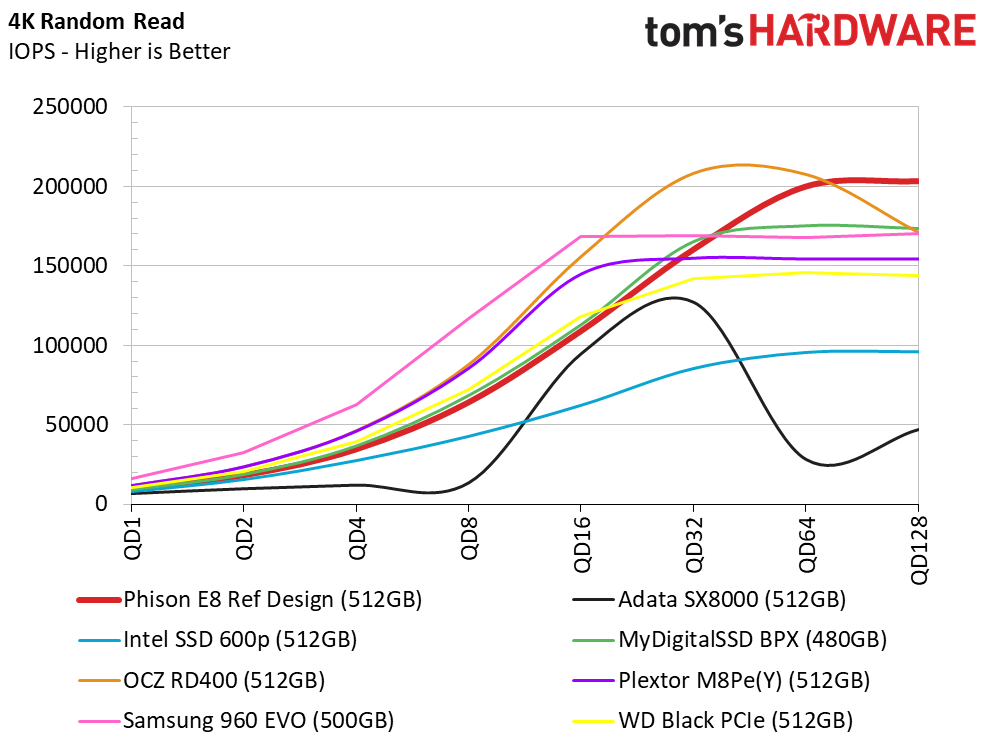

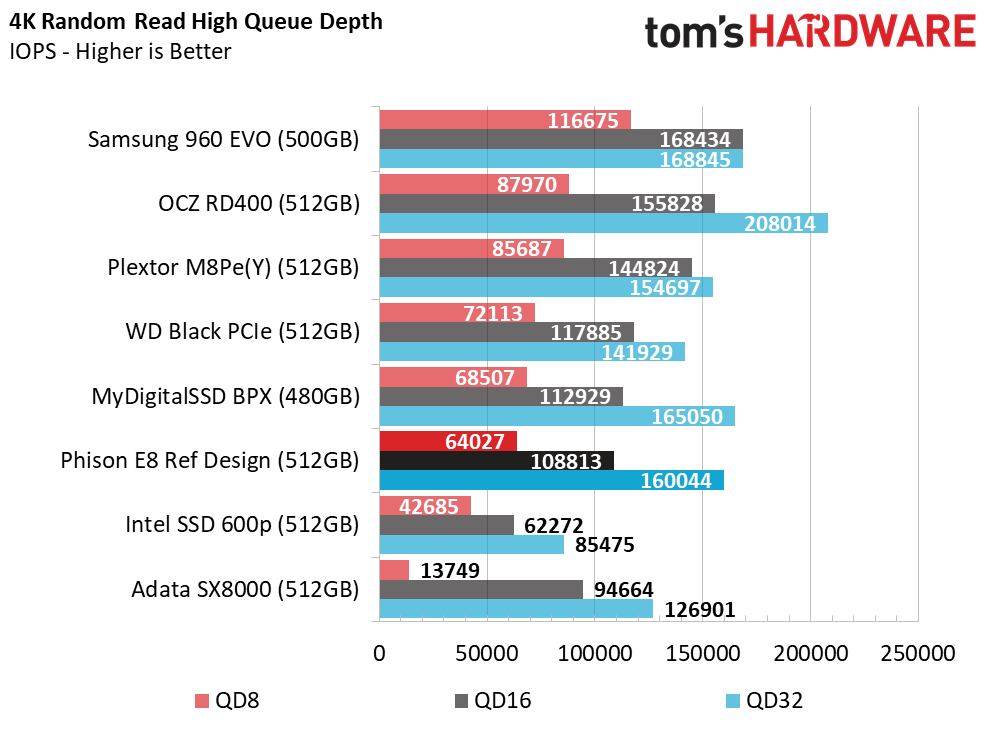
The reference E8 managed to outperform the MyDigitalSSD BPX in 4KB random reads at a queue depth (QD) of 1. The BPX later received a firmware update to get over the 10,000 IOPS hump at QD1, but seeing the low-cost E8 SATA replacement drive in the same range is impressive.
The E8 still keeps pace with the 8-channel E7-based BPX at high queue depths.
Random Write Performance
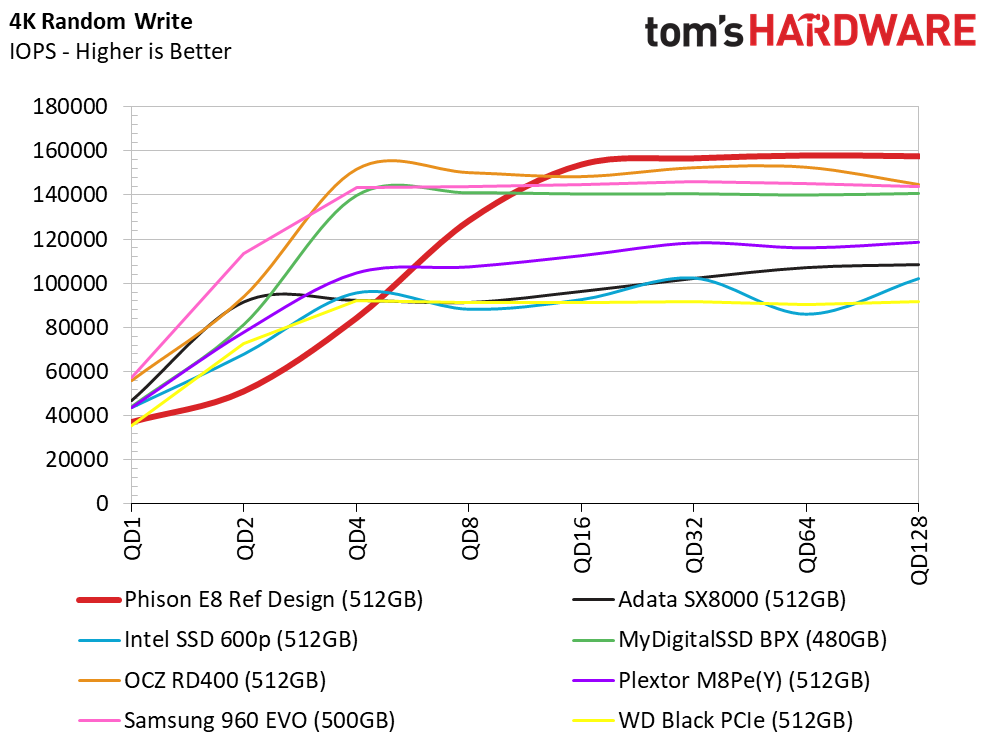


The E8 feels underpowered at QD1, but that's because Phison hasn’t programmed the middle power stages into this sample. However, it does outperform the competition at high queue depths.
The E8 should resume from lower power states faster and deliver better QD1 performance results when Phison implements the power states correctly. We'll be sure to examine this tendency when retail products come to market.
80% Mixed Sequential Workload
We describe our mixed workload testing in detail here and describe our steady state tests here.
Over the years we've written a lot about Phison's firmware development. The company makes large strides with each release and delivers increased performance in areas that have a direct impact on the user experience. The E8 outperforms every other product, except the Toshiba OCZ RD400, during the mixed sequential workload. The 100% read and write test results make this feat look impossible. The E8 reaches this level due to heavy optimization for mixed workloads.
80% Mixed Random Workload
At high queue depths, the E8 outperforms all the other products in the mixed random read test. Again, we spot low performance under light loads. We hope Phison and its partners can resolve the issue before the retail products come to market.
Sequential Steady-State


Entry-level NVMe SSDs won't be workstation champions like early high-performance NVMe SSDs. You might not achieve the best results possible just because the SSD uses the storage-optimized NVMe protocol. Most NVMe SSDs do outperform the best SATA has to offer, but not always. 3D NAND will virtually ensure NVMe's dominance if the controllers don't overheat and throttle during heavy workloads.
Random Steady-State


Our E8 reference design delivers roughly 6,000 random write IOPS in steady-state. Toshiba's BiCS3 NAND delivers consistent performance, but some other products deliver higher average IOPS. If the price is low enough, we could see some users buying two E8-based SSDs to use in a RAID 0 array.
PCMark 8 Real-World Software Performance
For details on our real-world software performance testing, please click here.


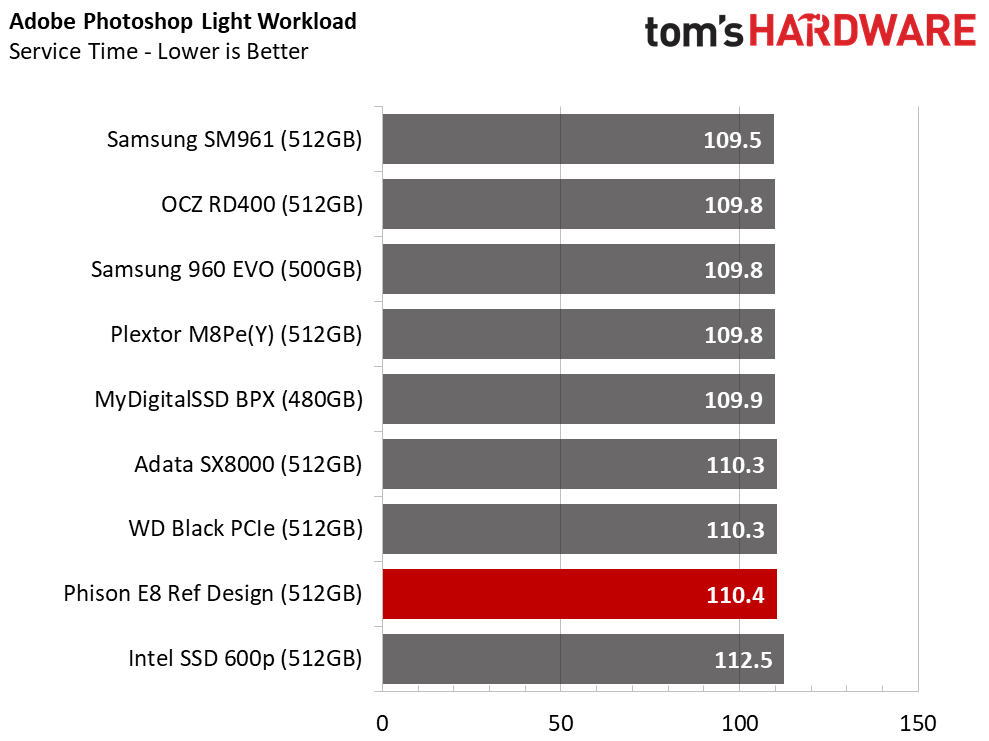







The E8 reference design outperforms the Intel 600p, Western Digital Black PCIe, and Adata SX8000 in most tests.
Application Storage Bandwidth
The individual results are very close, but we can see a little more separation. The three entry-level NVMe SSDs clump together at the bottom of the chart. The Adata SX8000 joins them, but the Samsung 960 EVO 500GB raises the bar another 100 MB/s.
PCMark 8 Advanced Workload Performance
To learn how we test advanced workload performance, please click here.


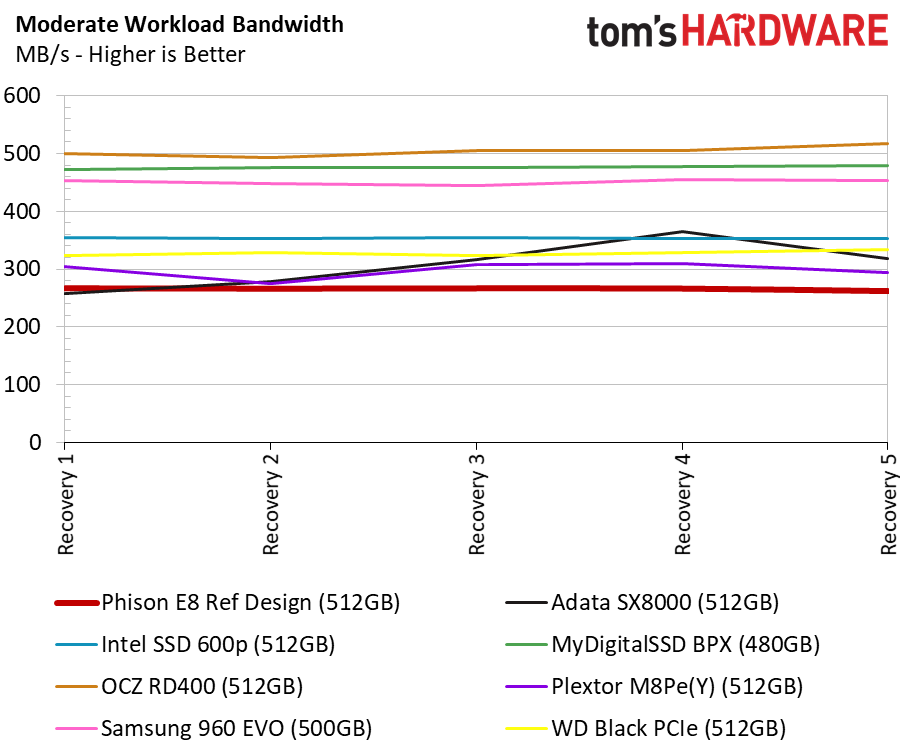
We begin to see signs of the unoptimized garbage collection algorithms. Phison warned us before we began testing that it hadn't fully optimized the background operations.
Total Service Time



With the underlying issues in play, we can't use our sample to see a true representation of recovery performance.
Disk Busy Time
The early E8 reference design recovers, but not as much as we like to see. The drive just doesn't recover fully in the limited idle time in this automated test.
Responsiveness Test


The power optimization issues come into play again. Without the middle power states our E8 reference design doesn't reach full performance as fast as it should. That hurts the real world performance because the initial ramp up from idle takes longer and introduces additional latency.
Even without all the power modes fully implemented, the E8 reference design does fairly well with power consumption. We expect this drive to be one of the power-efficiency leaders when it hits production.
Notebook Battery Life

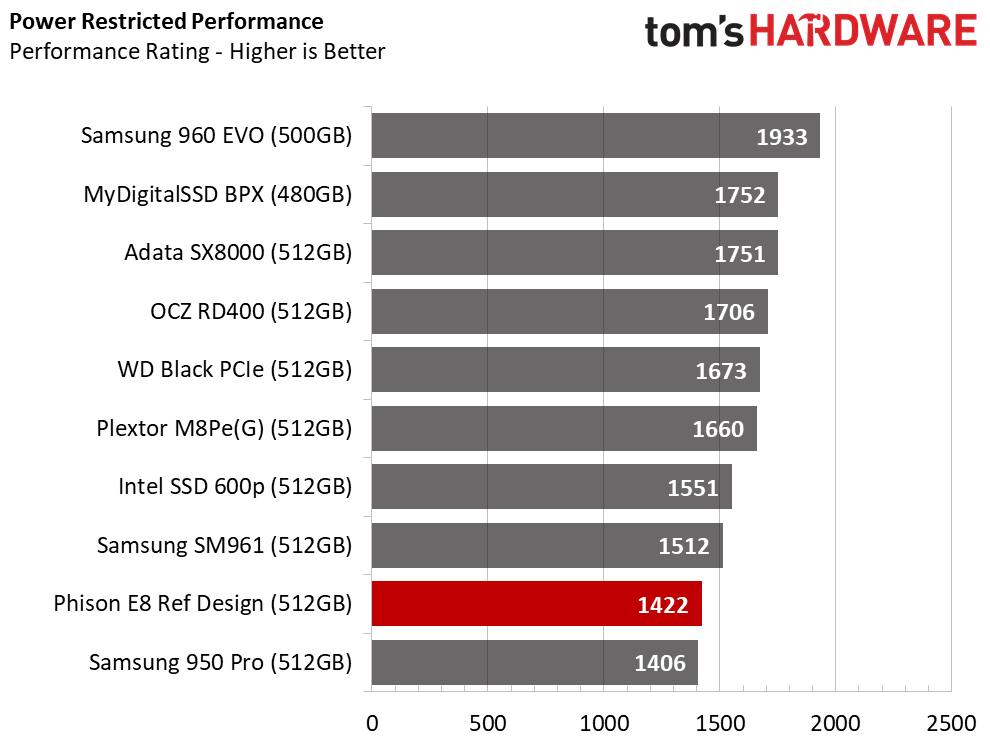
Even without the power optimizations, the reference design E8 delivers more notebook battery life than the MyDigitalSSD BPX's power-hungry E7 controller. We can't wait to see what the retail products do in this test. Optimized E8 NVMe SSDs may be the first NVMe drives worth buying specifically for long notebook life.
MORE: Best SSDs
MORE: How We Test HDDs And SSDs
MORE: All SSD Content
Current page: 512GB Class Performance Testing
Prev Page Phison PS5008-E8 Technical Preview Next Page Conclusion
Chris Ramseyer was a senior contributing editor for Tom's Hardware. He tested and reviewed consumer storage.
-
ravewulf "The DRAMless E8T will only scale to 1TB using Toshiba's new BiCS 3 TLC flash, but the E8 will scale to 2TB with the same NAND. It's important to remember that larger drives require a larger address map, so adding extra room for the map allows Host Memory Buffer technology to double the capacity of these entry-level products."Reply
Does this mean that both the E8 and E8T use HMB but the E8 uses it to double the capacity of the E8T? Because otherwise this is confusing as the E8T (using HMB) has half the max capacity of the E8, not double.
"The E8 delivers up to 1,100 MB/s of sequential write speed, but the E8T will only deliver up to 880 MB/s. The E8 delivers up to 280,000/225,000 random read/write IOPS. The DRAMlesss E8T delivers up to 125,000/115,000 read/write IOPS. The E8 is significantly slower than the E8T"
This part has to be a mix up. The E8T is slower than the E8, not the other way around. -
CRamseyer I see your point, it's worded a little funky. Until the Toshiba TR200, all of the DRAMless SSDs we tested only scaled to 512GB.Reply
As for the speed, yes that was flipped around and we will get it fixed asap.







